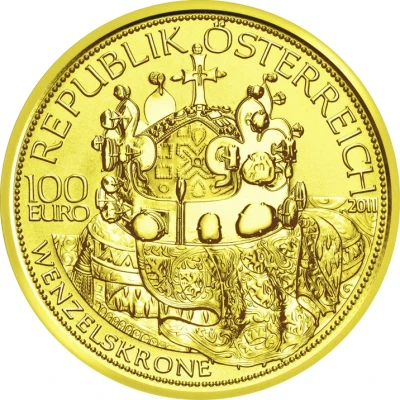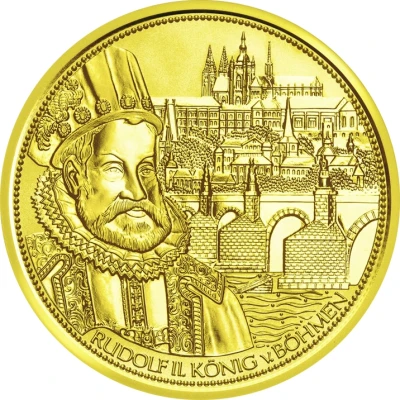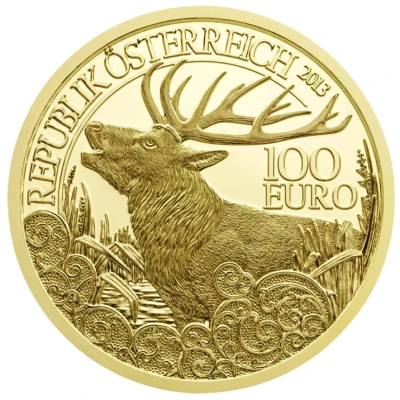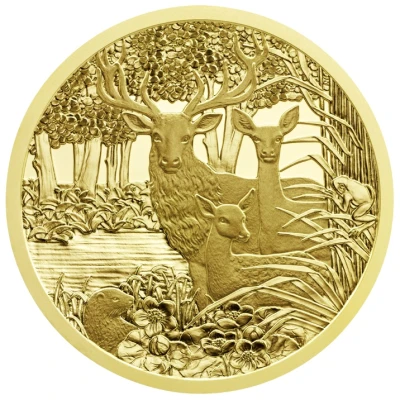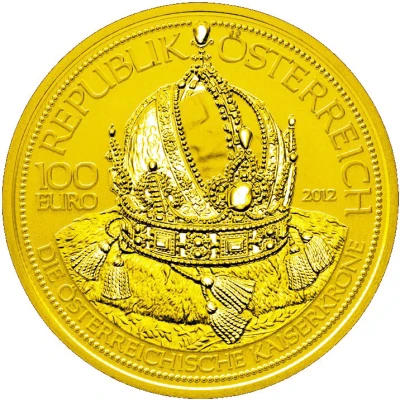
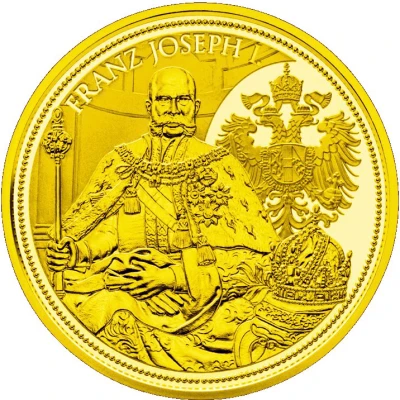

100 Euros Imperial crown of Austria
2012 year| Gold (.986) | 16 g | 30 mm |
| Issuer | Austria |
|---|---|
| Period | Second Republic (1945-date) |
| Type | Non-circulating coin |
| Year | 2012 |
| Value | 100 Euros 100 EUR = USD 110 |
| Currency | Euro (2002-date) |
| Composition | Gold (.986) |
| Weight | 16 g |
| Diameter | 30 mm |
| Shape | Round |
| Technique | Milled |
| Orientation | Medal alignment ↑↑ |
| Updated | 2024-10-04 |
| Numista | N#39930 |
|---|---|
| Rarity index | 87% |
Reverse
The reverse of the coin features a depiction of Emperor Francis Joseph I in the imperial robes of the Austrian
Empire. The image is based on a painting by Julius Viktor Berger, which currently hangs in the Vienna Supreme
Court of Justice. The Emperor is depicted with the richly embroidered robe, and over his shoulders is the
mantle of the Austrian Empire made of white silk, red velvet and ermine. On the left side of the mantle are four
elaborately decorated orders of the House of Habsburg. From the heavy gold chain across his chest hangs the
Order of the Golden Fleece. He is holding the Imperial spectre which, similar to the Imperial crown, is decorated
with enamel and set with precious stones and pearls. The Imperial crown rests on a lush cushion in the lower
right side of the coin design field, while in the background is the double-headed eagle insignia of the Austrian
Imperial dynasty.
This reverse was engraved by mint engraver Helmut Andexlinger. Helmut did give the Emperor a slightly more
friendly look in the coin portrait than in the original painting. Helmut found it “very challenging” to carry out the
very lengthy engraving work and execute the significant number of very fine details to eventually be included on a
coin that has a diameter of only 30 mm.
The Habsburg dynasty, which lasted over 800 years, did not believe that coronations were necessary because it
was a hereditary right. The Imperial Crown and the robes were used for the ceremonial investiture rather than a
coronation.
The Imperial crown of Austria was originally the personal crown of Rudolf II and crafted in 1602. It is considered
one of the best European examples of the art of goldsmithing of this time. Jan Vermeyen of Antwerp was
summoned to Prague to craft this very elaborate pure gold crown. Fortunately, this spectacular crown was not
dismantled after the death of Rudolf II but succeeded to exist in regal splendour to this day. It is kept in the
Imperial Treasury or Schatzkammer located in the Imperial Palace in the center of the city of Vienna.
The order of the Golden Fleece is one of the most prestigious orders of Europe, (the other being England’s
Order of the Garter) founded by Duke Philip and Princess Isabella of Portugal on the occasion of their marriage
in 1430. The order still exists today and the current head is Karl Habsburg-Lothringen. Other members today
include fellow royals from Europe.
The Order of the Golden Fleece was restricted to a limited number of knights. The power of the Order of the
Golden Fleece was mighty with the king, who was also the sovereign head of the order, consulting with the
members of the order before going to war, and deciding on most corner stone strategic moves of a kingdom. As
well, performance of members was also critically reviewed by fellow knights, and punishment was meted out
when deemed necessary and signed off on by 6 fellow knights
Script: Latin
Lettering: FRANZ JOSEPH I.
Engraver: Helmut Andexlinger
Edge
Plain
Interesting fact
One interesting fact about the Imperial Crown of Austria 100 Euro coin is that it features a unique design that showcases the imperial crown of Austria, which was once worn by the emperors of the Austro-Hungarian Empire. The coin's design is a representation of the crown's intricate details and craftsmanship, making it a valuable collector's item for numismatists and history enthusiasts.
Price
| Date | Mintage | VG | F | VF | XF | AU | UNC |
|---|---|---|---|---|---|---|---|
| 2012 | 30000 | - | - | - | - | - | - |
Values in the table are based on evaluations by sales realized on Internet platforms. They serve as an indication only for 100 Euros (Imperial crown of Austria) 2012 coin.
